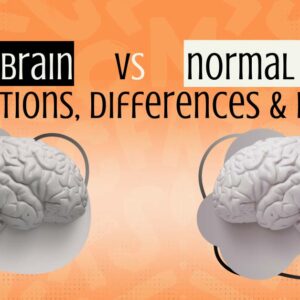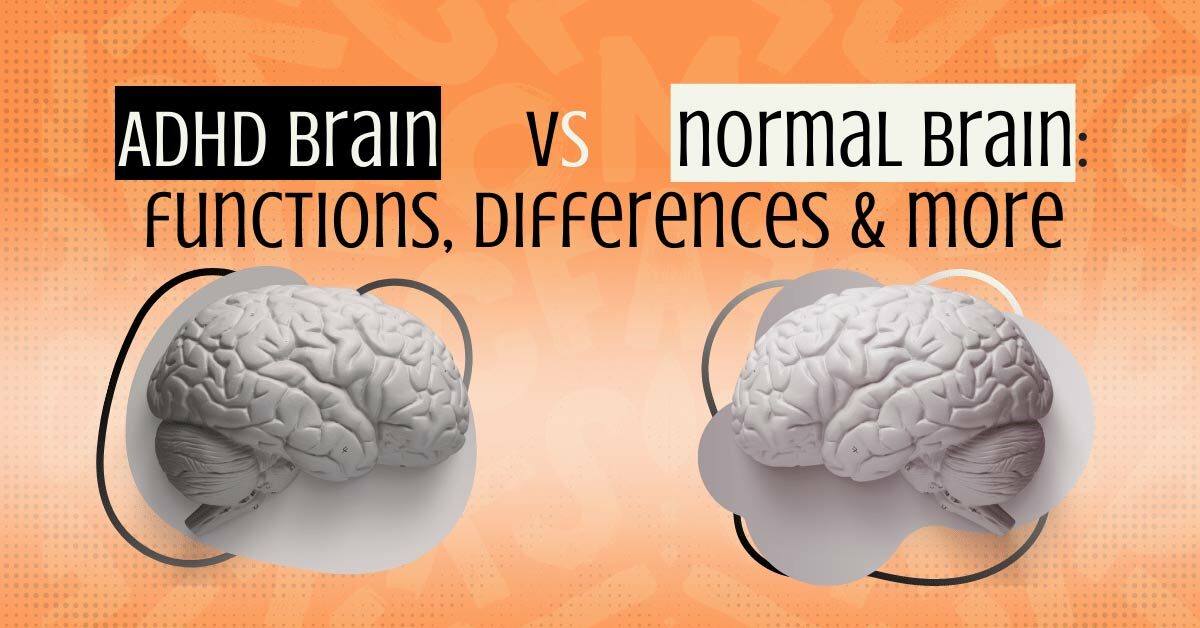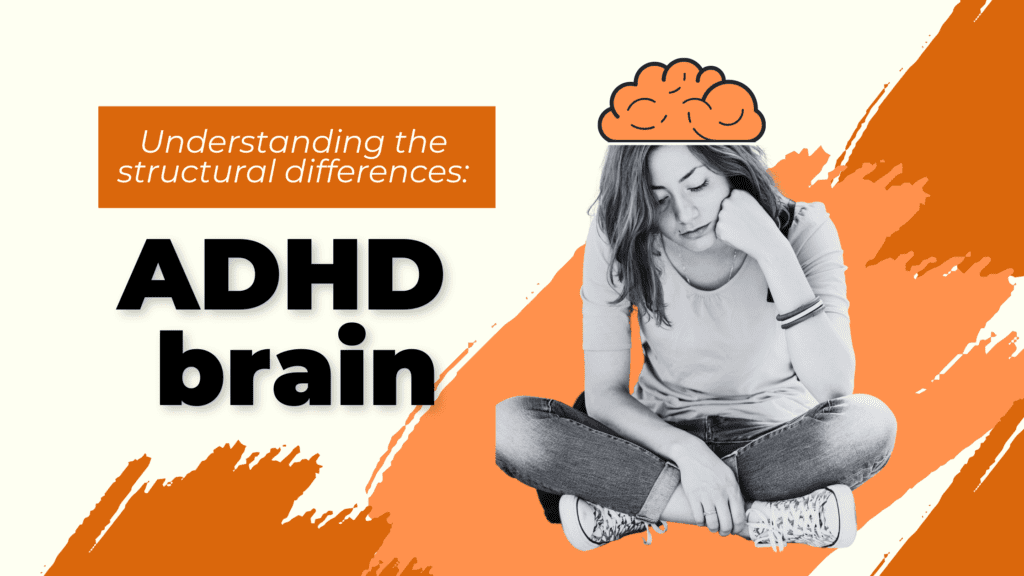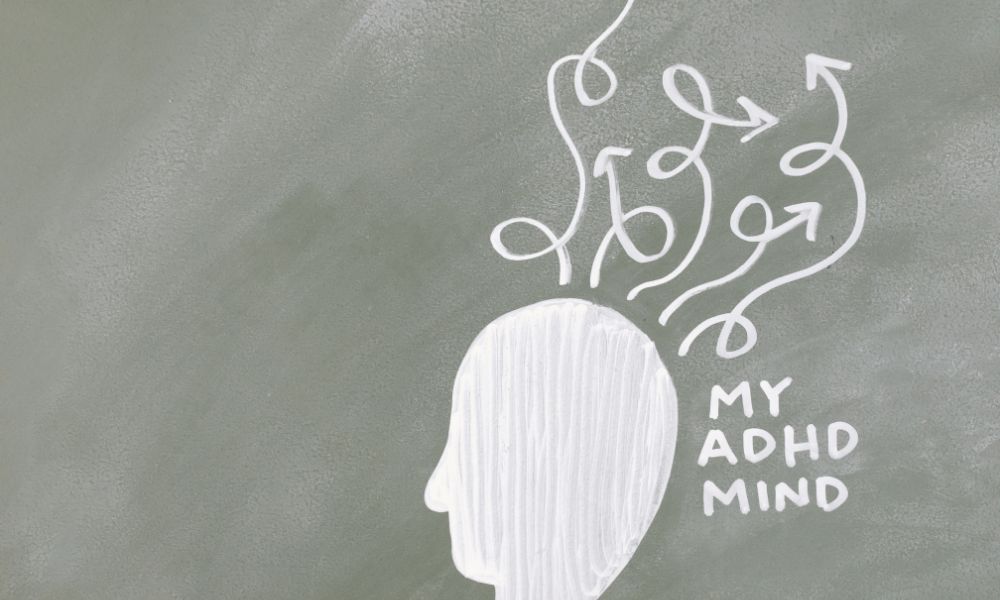
09 Sep ADHD Brain vs Normal Brain
ADHD Brain vs Normal Brain: Functions, Differences & More
ADHD, which stands for attention deficit hyperactivity disorder, is a neurological disorder that affects an individual’s brain. It is a disorder caused by the deficiencies of certain neurotransmitters.
The brain is a complex organ, which makes it all the more important to understand the structure and functioning of a brain with ADHD. Differences in brain wiring make it harder for individuals with ADHD to complete tasks and exhibit good executive functioning skills.
This article provides simplified information on ADHD brain differences—its functionality, structure, chemical activity, and associated framework.
An Up-Close Look at the ADHD Brain
The complete etiology of ADHD remains unknown. Different techniques like CT scans, magnetic resonance imaging (MRI), etc., are used to study the structure of the ADHD brain. The results help researchers learn the brain size and volume of specific areas.
Nowadays, researchers focus more on functional magnetic resonance imaging (fMRI) and magnetoencephalography (MEG) to reveal the oxygen uptake in different brain areas.
The fMRI and MEG are two standard non-invasive techniques that generate a very detailed structure of brain activity.
However, the fMRI results reveal that increased functional activity in some regions of the brain leads to restlessness and hyperactivity—the significant symptoms of ADHD.
The study with these techniques concludes that inefficiencies in the ADHD brain largely affect executive functioning skills, which include social skills, multi-tasking, organization, impulsivity, planning, and regulating focus, among others.
One major misconception about individuals with ADHD is their inability to focus. Someone with ADHD is more than capable of focusing and paying attention. The problem, however, is regulating it.
It is essential to know that while these brain scans are crucial in identifying the differences in functionalities and structure of the ADHD brain, these are not valid references to diagnose ADHD. ADHD is a medical diagnosis that requires proper medical assessment by health professionals like physiologists.
Understanding the Structural Differences: ADHD Brain
Studies have shown significant differences between a brain with ADHD and typically functioning brain. A brain with ADHD takes more time to mature, impacting an individual’s day–to–day executive functioning. Executive functions are essential to successfully perform daily tasks. However, brain size does not affect a person’s intelligence level.
The gray matter in the outer layers of the ADHD brain is less than normal, affecting the information processing function—the reason ADHD kids do things or act before thinking.
The primary reason for such abnormalities is miscommunication between different brain parts.
There are also volume differences in different brain regions like the hippocampus, amygdala, etc. The given parts are mostly affected areas of the brain due to ADHD:
- Prefrontal cortex and frontal cortex: – The major delay is in the development of the frontal cortex, which is responsible for planning, attention, and other cognitive behavior. However, on the other hand, the motor cortex develops faster than the normal brain, which causes fidgeting and restlessness in ADHD children.
- Striatum– It is the brain reward system, often referred to as the CEO of the brain. This part helps in processing feelings, thoughts, and emotions. Dopamine, which is responsible for regulating the feelings of pleasure, reward, etc., is also processed here. Generally, the striatum sends one signal at a time to the cortex to process the information. But in the ADHD mind, the striatum sends multiple signals to the cortex, making information processing difficult. As a consequence, kids with ADHD find it hard to regulate focus. The nucleus accumbens, putamen, and caudate nucleus are significant parts of the striatum that are affected.
- Amygdala– The amygdala plays a crucial role in controlling emotions in humans. However, this region is overactive in children with ADHD. Also, it is not well synchronized with the prefrontal cortex. Therefore, dysfunctioning in the amygdala makes it hard for ADHD kids to manage frustration or stay calm and patient.
- Hippocampus– It is primarily linked to long-term memory, learning, motivations, etc. The dysfunction in this area leads to hyperactivity in ADHD children.
- Nucleus accumbens– This part plays a vital role in linking motivation and action. The dysfunction in these areas leads to the struggle in completing homework and assignments. When children do not feel motivated to do specific actions because of a lack of reward, they don’t put in the effort.
- Putamen– This part contributes to managing the movement and impulsive behavior. Therefore, dysfunction in these areas causes restlessness and impulsivity in ADHD children.
- Caudate nucleus- It is the most critical region in the human brain. This part is responsible for storing and processing memories. Typically, this part helps kids decide on actions to achieve some outcomes. Kids with ADHD can’t remember the reason to do any task. Therefore, they leave their current tasks and switch to other tasks that seem to be more interesting.
- Reticular activating system– It is a crucial relay system among different pathways in the brain. Dysfunction in this area causes hyperactivity, inattention, etc. Proper functioning in this region is vital for maintaining the state of consciousness lacking in the children with ADHD.
- Limbic system– It is situated deep in the center of the brain. It is said to be the watchman of our brain. It alerts humans of harmful situations. It is a kind of alarming system. And if it doesn’t work properly, a child can mess up with stress management and sleep patterns.
Understanding the Functional Differences: ADHD Brain
Proper blood flow plays a crucial part in the functioning of the brain and body. Less blood flow contributes to the lack of executing functioning among children. Areas with less blood flow are said to be the underactive part. Therefore, children with ADHD struggle to control their emotions or maintain attention. On the contrary, regions with more blood flow are hyperactive, leading to restlessness.
Understanding the Chemical Differences: ADHD Brain
There are different chemicals present in the brain that help in communicating between the different parts and networks of the brain. These chemicals are neurotransmitters that help move messages from one brain cell to the next. However, in the ADHD brain, these messages cannot move efficiently.
Dopamine is a neurotransmitter responsible for sustaining attention and controlling the brain’s reward system. In the ADHD brain, many dopamine transporters are present without enough receptors, which causes messages to move quickly. As a result, the brain cannot process information and transmit important messages.
Moreover, due to the dysfunction of dopamine, kids don’t see daily routine work as rewarding. It also makes children have trouble waiting for their turn.
Norepinephrine is another neurotransmitter responsible for many crucial functions, including focus, energy levels, mood regulations, etc. It is also a stress hormone. Therefore, the improper functioning of norepinephrine causes mood swings, inattention, sluggishness, etc., among children with ADHD.
Another neurotransmitter, serotonin, affects social interaction, mood, behavior, etc.
ADHD affects the brain in different ways:
- Not enough neurotransmitters are released by sending neurons.
- Issues in catching up the neurotransmitters by the receiving neurons.
- The sending neurons call neurotransmitters back before they can make any meaningful connections with the receiving neurons.
What steps should I take – A word from Themba tutors
Getting your child diagnosed with ADHD is can be overwhelming and even frightening for some parents. It is difficult to know how to proceed further. Themba Tutors has counseled a number of children with ADHD and their parents. We know the journey is not easy. Parents often think they have failed their child or it is just a result of poor parenting—but that’s all a myth. ADHD is a neuropsychological disorder that has nothing to do with parenting or a child’s laziness.
ADHD affects the brain, and it’s clear that they need our help!
The best solution is the multimodal approach, which combines medications, behavioral therapy, and executive functioning coaching. All these can help promote brain development.
Your relationship with the child is the most powerful treatment for ADHD.
Create a comfortable environment and provide the necessary support for your child. Practice patience. Maximize your support to the child; if needed, seek the help of professional coaching providers to understand your child’s needs better. Highlight your child’s strengths, efforts, interests, and accomplishments—make them feel confident.
Check Out Our Blogs:
- Understanding Neurotransmitters: Dopamine and Norepinephrine
- The Role of Brain Imaging Techniques (MRI And FMRI) in ADHD Research
- How the ADHD Brain Works Differently and Why That’s Not Always a Bad Thing
————————
Looking for an ADHD/ADD Coach? Chat with Themba Tutors Today!
Our ADHD/ADD coaches travel to your home.
We travel to the following locations: Manhattan, Brooklyn, Queens, Staten Island, Bronx, Long Island (Nassau & Suffolk Counties), Westchester County, Connecticut (CT),and New Jersey (NJ).
Have a free consultation today.
Call: (917) 382-8641, Text: (833) 565-2370
Email: [email protected]
(We respond to email right away!)
References:
https://www.additudemag.com/current-research-on-adhd-breakdown-of-the-adhd-brain/
https://www.verywellhealth.com/adhd-brain-vs-normal-brain-5210534
https://www.understood.org/en/articles/adhd-and-the-brain
https://qz.com/914046/proof-that-adhd-is-a-brain-disorder-the-brains-of-those-with-adhd-are-smaller-than-the-rest-of-the-population/
https://babyyumyum.co.za/the-adhd-brain-versus-a-normal-brain/
https://www.psychologytoday.com/us/blog/the-reality-gen-z/202112/7-ways-adhd-can-be-seen-in-the-brain
https://www.additudemag.com/neuroscience-of-adhd-brain/
https://www.addsolutionsnj.com/differences-in-brain-structure-for-children-with-a-d-h-d/
https://directindia.org/resources/adhd-and-the-brain-2/
https://www.webmd.com/add-adhd/childhood-adhd/news/20021008/adhd-kids-have-smaller-brains
Craig Selinger
Latest posts by Craig Selinger (see all)
- Psychotherapy and Support Services at Cope With School NYC - April 12, 2024
- NYC Parents of Teens Support Group - April 8, 2024
- Here I Am, I Am Me: An Illustrated Guide to Mental Health - April 4, 2024




No Comments